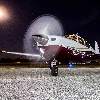Leaderboard
Popular Content
Showing content with the highest reputation on 12/20/2017 in Posts
-
UPDATE 12/19/2017: At last, I Closed on the airplane today. Sent all the "goodies" to the FAA office for filing. Time to get greasy and tear into this thing tomorrow first thing. Goal is to have it at Sun N Fun 2018 all done up.8 points
-
The best headset is the one you can afford and can wear for 5+ hours a day without noticing its there. That's different for everyone. For me its the A20, I have logged close to 10hrs in a single day as PIC with it on and you actually forget you are wearing it. I think the Halos are awesome but I don't like the idea of something being stuck in my ear for long periods of time.6 points
-
When I was headed to Florida last year in the Rocket up at FL230, I was going through Chicago Center airspace over the lower east end of Lake Michigan around 7 on a Saturday morning. I had been with the same controller for about 25 minutes but could hear him very clearly has he was working a string of airliners into the ORD transition. He comes on and asks "N1017L, are you still with me?" I immediately called back that I was and heard him loud and clear. No response from him. I'm thinking, OK....this isn't good and call back that I hear him loud and clear. He replies "stand by, I'm looking to see what frequency I need to send you to." He gives me my new frequency and I report up to the next controller (I think it was Indy now). The controller says" yes, we've been waiting to hear from you". I replied back I was never turned over until just now. A few minutes later the new controller comes on with the good old "N1017L, I need you to take this number down and call when you land, concerning a possible pilot deviation." I took it down, didn't say any more....now that god and everyone now thinks this GA Mooney pilot screwed up. My only statement was for him to advise the supervisor I would be in the air at least another 2 hours before I landed in Tennessee. Now I had 2 hours of gut boil....did I miss a hand-off? Man, I know my N number like my name, having this plane for over 17 years. My wife says "I didn't hear a hand-off and I was listening the whole time too". When I landed in TN, I called the number even before fueling. A guy named Tom answers (my name as well, so easy to remember) on the first ring. I identify myself as the Mooney he was expecting a call from and, with some thought, mention it "appears we had some kind of radio snafu". He doesn't really say anything, leaving me to feel like I have to explain. I said I was in radio contact with the controller the whole time, never sensing there was an issue. He still doesn't say anything. I further mention I fly a lot of night time medical missions, and didn't find it unusual to be with one controller for a while at that time of the morning as I know they combine sectors when the traffic is lower. With still no response I finally add, my wife was listening and I've had this plane for 17 years and don't believe I missed a hand-off. I think you should check the tapes. He finally comes back with "yes, we checked the tapes and you WERE NOT handed off as you should have been." He further explains the exact scenario I described, the combined sectors at night, were being re-distributed to more controllers as the traffic was coming up and somehow my plane got missed as they were moving planes out of the one controllers responsibility. He took my name, address and phone number, but assured me it was for their end, not an issue with me. EVER SINCE.... I now keep a log on my knee board of every hand-off; the controlling agency, the new frequency, the time, and a check mark when the new controller has been contacted AND acknowledged me on the new freq. If there's been some time since the last frequency change, I call and query if I'm still supposed to still be with that controller. Also...at the recommendation of peevee , I keep my standby radio on the emergency frequency, as this is the first place they will query for you if lost in the system. Tom5 points
-
5 points
-
4 points
-
4 points
-
4 points
-
Well, it seems it is not a question of if, but a question of when... Today I was flying back from KESN to KGAi. I was at 6000 feet and hear that ATC is telling an airplane to descend to 4000 feet. Because its call sign was very similar to mine, I thought they were talking to me. Now, my call sign finishes in 41V the other one in GV. I asked for confirmation and was told that GV should descend, I repeated my call sign and confirmed that I was descending. I went down to 4000. After a while ATC calls me and starts deviating me around... obviously I thought I was too slow, or did not descend fast enough... But, no! He gets back to me telling me about a possible pilot deviation, gives me a phone number... I landed (not my best landing...), and called, after conferring with AOPA what to do (do you subscribe to their legal service? I did not until today). ATC tells me very politely the supervisor would be listening to the tape and get back to me if there was an action to be taken. After about 20 min (time I used to fill out a NASA form, but is it too late?) I get a phone call from a number I did not know... I was so nervous that I did not answer and it went to voice mail. So I called back right away... I imagined black helicopters, police cruisers coming to the airport to pick me up... I was transferred to the supervisor, a nice lady told me that she did not call me, but the quality assurance team had called me to let me know that they had listened to the tape and that it had not been my mistake, that I had inquired if the instruction had been for me and then I had confirmed that I was descending... and that ATC did not catch it. She apologized for the inconvenience and I started to breath again. So not all ATC stories are horror stories, on the contrary. After the fact and listening to my own tape (did you ever listen to your own transmission? I wonder how can they understand me?), I learned that I should be clearer and speak slower. I also thought that it was very nice for them to call back to let me know that everything was OK. So that is the story.3 points
-
I’m thinking this would be the definition of minor mod. Same thing as wiring your stratus or GDL-39 to ship power.3 points
-
UPDATE: A very thorough firewall forward inspection by the folks at Tennessee Aircraft Services at KMKL identified a loose v- band clamp (not the AD clamps, the smaller one forward of the turbo) as the only place that could be leaking exhaust. It’s fixed, but the weather today was 400 overcast, not good enough for a functional check flight. So I rode home in a Caravan and will return to do the FCF and subsequent flight home when the weather improves. More to follow. Cheers, Rick3 points
-
2 points
-
I've had getting one of these on my list and just haven't gotten to it. The coupon code still works - saw this thread and ordered one yesterday.2 points
-
Even living here on the East Coast, once you get used to turbo capability it is hard going back!2 points
-
Just a nosy question. Have you eliminated the M20M Bravo? Many of the Bravo owners on MS refer to them as their "private airliner", and I would think you could find a plane in your price range with the equipment you say you would like.2 points
-
It’s like flight bags, you need to find one that works for you. Like almost everyone else, I started with Clark passives, then bought the original Clark ANRs, only to find my noggin was being squashed like an overripe melon. I moved to the original Telex ANR and wore them until they broke and couldn’t/wouldn’t be fixed by Telex. I took them up on their $300 towards a new pair of ANRs only to find a hated the fit. I then bought a pair of Lightspeed first generation Zulus, then a pair of Halos, then Clarity Alofts, only to find myself back to the Zulus unless it is really hot out. Do you think this discussion is in the same category as women and their shoes? Sure feels the same. Sent from my iPhone using Tapatalk Pro2 points
-
2 points
-
I'm ambi-uptus (new word alert). I learned to turn my paper sectionals track up as a student pilot for the reason you mention, but went north up on IFR enroute charts to make them easier to read. I can't even imagine trying to read an approach plate track up. Moving into the GPS world, I prefer track up. On my tablet apps, it's north up, consistent with my IFR chart practice. So, I'm basically track up in the certified box and north up on the tablet. Strangely enough, I have a lousy sense of direction but the system has actually helped.2 points
-
Thanks Mike. It is nice to see such positive things coming from my crash. Not only CO awareness but my personal relationships as well. I have always been grateful for my friends and family, but now it’s 10 fold. Life is good. cheers, Dan2 points
-
When I fly with O2 or even just on long trips, I take the Halo frame off my head and let it sit around my neck. The tubes are long enough to still allow the ear buds to stay in the ears. This allows me to easily use a mask when I'm up high in the flight levels, and even easy with the cannula down lower. It's like not wearing a headset at all. And on the rare occasions that ATC has something to say to me, I just pick up the mic and speak into it.2 points
-
I took my full size mountain bike to BurningMan with me. I took off the front wheel, seat, and peddles. It all went fine through the door into my 252 with the back seats removed.2 points
-
2 points
-
Halo's hands down for comfort, clarity, weight, etc, etc. did I mention comfort? Only downside is they sell out quickly when he has them in stock (as late as last Thursday for the last batch). I use the black foam tips and they are super comfortable and the reduction in noise is as good as any expensive ANR headset out there. Add in the fact that I've never gotten a headache after wearing them for more than an hour like I did with my old DC's and the pair of Bose I wore in a friends Cirrus. However, do you like sticking things in your ears is the big question. If you can wear ear buds, the Halo's shouldn't be a problem. Some folks just aren't comfortable with the inserts over long periods of time and I totally get that. You can buy 2.25 Halo's ($389) for the price of the Bose and Zulu's, so there's that to consider. Buy them to try out and if you don't like them, they sell quickly when advertised here or on any other forum - even at full MSRP to get your money back Cheers, Brian2 points
-
It’s raining 337’s here today! I received Matt’s and Marauders 337’s today. The FAA actually beat me to getting the paperwork done before the job. Time to get Matt’s flying for data reports! David2 points
-
The repair is going nicely and we hope to have her back by the end of next month.1 point
-
1 point
-
I like my Halos but they lose miserably in this department. They make you look like an aerobics instructor. I found the Halos difficult to get used to, once I did they are really comfortable. Mike's Garth quote is spot on. Cheers, Dan1 point
-
IRAN on mags is a must. Thanks. They will be coming off the airplane tomorrow and in the mail. thank you.1 point
-
I, and many others here, use Blackstone Labs for oil analysis. https://www.blackstone-labs.com/1 point
-
I vote for bose A20s. However, a cheaper alternative if you don't want to drop 1k is to buy the quiet comfort bose head phones and then add the UFlyMike. I have two of each and honestly the A20s are only marginally better IMHO.1 point
-
I have one of these. It is a full sized mountain bike and you can actually even ride it off trail with no excuses if you buy the better one with a quality shock. https://www.montaguebikes.com/product/paratrooper/ AND if folds instantly and if you take both wheels off the frame can be put into the airplane through the baggage door - and I put the wheels in a wheel bag (to keep the plane clean) and they go through the door very easily. One bike can be carried with the rear seats in place. Wheel bag: https://www.amazon.com/Padded-Double-Wheels-Separate-Compartments/dp/B005P9RA2M/ref=sr_1_2_sspa?s=sporting-goods&ie=UTF8&qid=1513737613&sr=1-2-spons&keywords=bike+wheel+bag+double&psc=11 point
-
They will, but I'd recommend learning how to take apart a bike. as in take the forks off. its super easy once you do it a couple times.1 point
-
My J will stall straight if I keep the ball centered, and she flies straight true and level both with and without flaps. My friend just bought a J and the ailerons are noticeably drooping, but I don't know what it looks like in flight. He's about to finish his PP and then transition to the Mooney. His instructor who he will also use for transition used to own a Mooney and I told him to make sure the instructor knows it is out of rig and may not stall straight. In the spring we will take it down to KMRN to have the rigging adjusted, and if we are lucky maybe even meet @Bob_Belville1 point
-
1 point
-
1 point
-
Well, the only comparison I can help you with is that I went from DC's with the ANR upgrade to Zulu 2's and now Lightspeed PFX's. I love my Lightspeed PFX. It is comfortable and does well with noise cancelling. Not sure what difference it makes compared to Bose or others but the PFX continuously samples the noise both inside your ear and outside to adjust the noise cancelling. Could be hype, maybe not but they do well in my C model to keep things quiet. The cord is also a braided cord that is more like a rope. It does not get twisted, does not kink and can even be tied in a knot to hang it up somewhere. Yeah could be marketing but to have a cord that does not get twisted up is good.1 point
-
I've been in there a few times. Had a hell of a time hailing Mcguire approach but other than that its a decent, quite spot. I think @Cris is based there with his Eagle.1 point
-
Nice writing, PK! Other Paul (Rocket), Thanks for bringing PK's writing here. Best regards, -a-1 point
-
I have a dental meeting in June at Omni Amelia Island Plantation. I'll keep that in mind when they open up registration.1 point
-
There is a huge advantage in earning your IR in your own plane... A CFII that wants you to train in a different plane sends up more than one red flag... Adjustments on approach are often small, timely, and really well known in advance... There is an equivalent debate like the ROP/LOP, but specific to the IR crowd... When following the ILS (or WAAS gps equivalent)... how to make fine adjustments/corrections in direction... they can be done in one or two different ways... Coordinated rudder/aileron rudder only There are advantages to both... take your pick. PP thoughts only, not a CFI .... Best regards, -a-1 point
-
I completely agree, and appreciate you sharing the details. Glad ATC was able to acknowledge it and that you were ok. We're all one big team up there. Sometimes I think this topic gets overlooked, so am glad you brought this back to the forefront of our minds.1 point
-
What a great success story! Great response. So glad that the unit alarmed and you responded well. We just replaced our in home unit. Don’t forget those to everybody. Cheap protection. Looking forward to hearing what “culprit” was in the high levels of CO.1 point
-
The mechanism is clever. It has two stable states, open and closed. Either the cable or the rods going to the flaps is adjusted too tight so the mechanism can't go to the closed state. You can test them on the ground by pulling them open. You shouldn't be able to.1 point
-
1) I have found putting the gear down when I'm just above the glide slope intercept works well for staying on the GS. The trick for me is to slow down to gear speed before the FAF and I generally need to be in level flight to do it unless I'm going to chop power significantly. Sometimes I find myself a little behind and in the white arc to put 10 degrees of flaps down before I slow down to 120mph and then once I hit the FAF, get the gear down and I may already have 10 degrees of flaps. Don't be afraid to use your flaps to get that little extra 10mph slow down if necessary. Power settings are largely dependent on headwind component, temperature and other factors so I just try to fly whatever power settings give me the speeds required and a 500-700fpm stabilized descent (of course, if large headwind then maybe only 300fpm, etc). Sometimes it's 18", sometimes it's 16", sometimes 15". 2) I try to slow down to about 75 knots around the MDA -- if you're a little faster that should be fine too, just pitch up for the slower airspeed after adding power without being excessive to let yourself get the J bar up. Good J bar technique is helpful too with it being one solid motion, but sometimes it can be a struggle. Not sure if this was helpful at all, but good luck on your instrument rating. It was definitely the most useful thing I did all year flying-wise.1 point
-
Update on replacing wiring harness and all plugs: No real change. Engine still backfires and runs rough. Max static RPM did go up a bit to just under 2400 RPM. I think this small improvement in max power is a result of all new wires and plugs. Just like doing a tune up on a 1963 Chevy. If you wanted it to start in the winter in northern Indiana you did a tune up of new plugs and points every fall and new wires every two or three years. Next steps are to pull Both Mags and take them to a Mag shop and have them bench tested under load. Overhaul if anything is abnormal. Have also decided to shut the door after the horse ran away, and when I am finally able to get the plane to the avionics shop, I am going to have a JPI 900 installed. I'll keep everyone posted on progress with the Mags. -mark1 point
-
About 6 months after buying my last airplane my autopilot needed some work. I called the avionics shop that did the install originally with the previous owner. When they looked up my N number they said they hadn’t finished the WASS upgrade to the 530 that the previous owner had started. He said the box was updated but I still needed the new coax and antenna. I questioned why I needed new coax because I though coax was coax. He said what they originally installed in 2005 was not compatible with WWAS. I told him I hadn’t noticed any problems so far. He said there was a chance of having gps reception problems. I was under the impression all WASS upgrades required new coax. Was the correct coax available before WASS and I just had the cheep stuf? Maybe you need to replace the coax. Cheers, Dan1 point
-
1 point
-
Unquestionably the cheapest option here since you already have a WAAS GPS, is to do a 330ES transponder. They can be had on the used market for less than $2000 and the install is often less than $500. It's quick, cheap and gives you full ADSB compliance for all altitudes. There are many other options with many more features and options... but all come at a cost. This is what I did for my C. I bought a 330ES from @Alan Fox and my avionics shop installed it for $400 while I waited. Easy, cheap, done.1 point
-
As a survivor of a bad traffic accident, seat belts with shoulder harness and air bag, is why I am here today. I has surprised with the size of the air bag (small). How big are the air bags in the shoulder harness for our planes? Which side of the harness is it? What are the maintenance requirements? My accident was 3 weeks ago, I have a lot of time now, 5 fractured ribs, nose and 7 staples in my head. 2007 Jeep Wrangler and a very sudden stop. An airplane cabin does not look crash worthy compared to even older cars. If you do not have shoulder harness’s in your plane, get them. With air bags would be better. Ron1 point
-
Sorry for the wordcount, but I felt this info may help when considering paint processes. We use Eldorado PR5044 paint stripper as specified by PPG Aerospace. Eldorado PR-5044 is the newest generation, nondrying, peroxide-activated paint and primer remover for removal of polyurethane and epoxy paint systems. PR-5044 is environmentally compliant, contains no chlorinated solvents and is the only peroxide stripper approved by Boeing. It is approved by or conforms to: BAC 5725, DPM 5549, Boeing D6-17487, Douglas CSD #1, Embraer, WR-ALC Purchase Description, ATR. A single application of the PR5044 stripper will strip two coats of paint with an additional application possibly necessary to fully strip the airframe if the plane has had previous paint jobs done without stripping to bare metal. There is no abrasive agitation needed for this stripper, it is non-corrosive, and is washed off with fresh water and an alkaline soap to neutralize any remaining active peroxide residue . The airframe is unmasked and rewashed, with close attention paid to seams and other areas where residual stripper residue may linger to ensure there is no chance of contamination of the new coatings. 1. After allowing the airframe to fully dry we remove all access panels begin removing the remaining paint from masked areas. Again, this is where we like to point out where the proper process diverges from the norm because of diligence in ensuring the least destructive methods possible when preparing your airframe. We remove the remaining paint from the aircraft skin using 3M Scotchbrite products ONLY. No conventional sandpaper is used for paint removal from aircraft skin after stripping so there is no chance of inadvertently reducing the thickness of structural components such as rivet heads, window openings, etc. or altering the profile of the existing aircraft skin which reduces the aesthetics in addition to reducing the service life of the skin and making it susceptible to corrosion because of Alclad abrasion. I am currently painting a Conquest that was damaged by another "paint shop" to the tune of $275,000.00. Our structural repair department had to re-skin a considerable portion of this airframe. 2. The next step of the process is another area where many shops using "old methods" botch the aircraft preservation portion of the painting process. As specified by PPG Aerospace and in accordance with current Boeing practices, we use a conversion process in preparation for primer that does not use acid etching or an alodine oxidizing agent. The old method of preparing and converting aircraft aluminum and magnesium for priming consisted of treating the aircraft skin with acid to remove contamination and then treating with Alodine. The problem with the acid process is somewhat self explanatory because you cannot absolutely ensure complete neutralization of the acid that may have crept into the seams and airframe interior cavities, thus leaving a corrosive to sit in the lap seams and every other orifice where it will react, especially when exposed to moisture from rain or even just high humidity. This exposes the airframe to numerous opportunities for future corrosion issues. And, aside from the fact that Alodine is a Hexavalent Chromium wich is a known carcinogen, it is an oxidizer. What many do not realize about Alodine is that the application of it is to start a controlled oxidation (surface corrosion) and then stop this process by sealing it with primer. The oxidation of the aircraft skin is to provide a surface condition the primer can adhere to by creating a thin layer of oxidized aluminum. The same is true of the process for magnesium. After application of the oxidizer, you have 48 hours to seal it off with primer or the oxidation process will progress too far, resulting in adhesion failure of the primer due to exfoliation of the oxidation layer, or worse, the development of corrosion under paint. This often happens when an aircraft is acid etched and alodined and then allowed to set too long, awaiting primer, because of improper management of the paint shop work schedule. This is often evident when "bubbled" looking paint is seen with corrosion underneath and no damage to the paint that would explain the development of the corrosion. Or, the aircraft skin had other contamination from traditional corrosion inhibitors due to improper surface preparation. We use the PreKote system of airframe skin conversion. PreKote is non-toxic, biodegradable, and NON-CORROSIVE with a pH of 10-11.5. Chromated conversion coatings (such as alodine) are highly corrosive acids (pH of 1.3–3.0). PreKote also will not cause embrittlement or induce Cadmium leaching on Cadmium-plated metals and is approved on all composites and all metals, including magnesium and titanium. After passing numerous paint system specification tests by the US Air Force, Aerospace OEM's, and USAF flight-testing, the USAF specified PreKote as the only replacement for chromated conversion coatings in Tech Order 1-1-8, the umbrella Technical Order for aircraft painting. PreKote has been qualified and is being used on the fleets operated by Continental Airlines, Air Canada, Delta Airlines, Southwest Airlines, United Parcel Service (UPS), and American Eagle among others. In addition, OEM's including Dassault Aviation and Mooney Airplane Company have approved and implemented PreKote for production aircraft. 3. After the conversion coating, the aircraft is masked and primed using the PPG Aerospace primer appropriate for your coatings system selection. Once again, this is another critical aspect of the aircraft painting process that is often mishandled by conventional paint shops, resulting in inferior coatings performance or outright failure of the paint system. All coatings have a period of chemical activity, meaning that even after drying to the touch the coating is "cooking" at the molecular level. Primer has a window of chemical activity, typically 72 hours for our product, in which the topcoat must be applied to achieve a chemical bonding between the two coatings. On numerous coatings systems this window may be considerably less. If the topcoat is not applied during this window, the primer must be mechanically abraded in order to get mechanical adhesion of the topcoat with the primer. This causes two major issues. First, the abrasion of the primer defeats what it's designed to do; protect the aircraft skin. All coating are designed to be applied at a minimum dry film thickness. This optimal thickness provides corrosion protection and flexibility. Without maintaining this minimum thickness, the primer can and will prematurely fail. Second, it is impossible to fully abrade every little bit of surface area like tight skin seams and around rivets. This causes weak bonding areas between the primer and topcoat which will lead to delamination between coatings. This additional abrasion process also allows the possibility of contaminating the primer with skin oils, air tool lubricants, etc. Hitting this window of molecular activity ensures that EVERYWHERE the paint flows and is in contact with the primer there is a chemical bonding of the coatings. In essence, the topcoat and primer become inseparable because they have become one coating at a molecular level. Hope this sheds some light on what you "should be getting in addition to a good "looking" paint job.1 point
-
I'm soured on work in Mena in general after my experiences there. I think there is an underlying cultural problem with that area about following directions, using maintenance manuals, etc. There is no reason to sand an entire airframe IMO! Especially with unskilled labor. Are you even sure the Mooney skins have a clad layer under the paint? Sheet aluminum can come in clad (both sides), clad (one side) or un-clad. It wouldn't surprise me if only the interior side were clad since the exterior is presumably protected by paint... if that is the case then sanding will be eating into the structural aluminum. If I were to do it over, I might consider your option of stripping and prepping myself/at home, and then delivering to a shop for the paint. You don't need a clean hangar to strip and alodine... just some anal retentive tenacity. I'm worried about my paint shop's lack of diligence and the durability of my paint. At the next annual after paint I found corrosion in my spinner bulkhead where they didn't get the stripper cleaned sufficiently. Hell, they should have removed the spinner prior to applying the stripper in the first place, especially since I gave them a freshly polished spinner to install! I wonder what else they didn't do properly...1 point













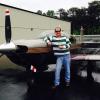

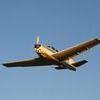

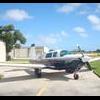








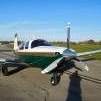



.thumb.jpg.ae084ff98f2eda1b3f595ed45b9592c9.jpg)

